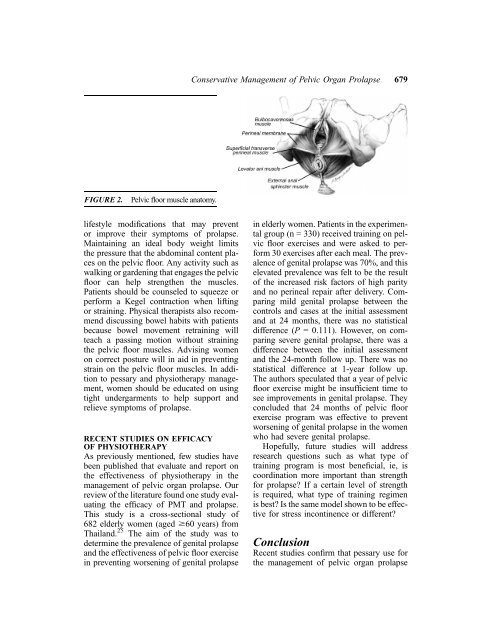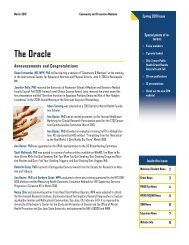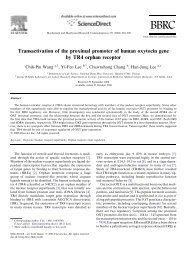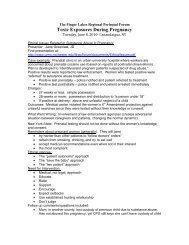Conservative Management of Pelvic Organ Prolapse
Conservative Management of Pelvic Organ Prolapse
Conservative Management of Pelvic Organ Prolapse
You also want an ePaper? Increase the reach of your titles
YUMPU automatically turns print PDFs into web optimized ePapers that Google loves.
FIGURE 2. <strong>Pelvic</strong> floor muscle anatomy.<br />
lifestyle modifications that may prevent<br />
or improve their symptoms <strong>of</strong> prolapse.<br />
Maintaining an ideal body weight limits<br />
the pressure that the abdominal content places<br />
on the pelvic floor. Any activity such as<br />
walking or gardening that engages the pelvic<br />
floor can help strengthen the muscles.<br />
Patients should be counseled to squeeze or<br />
perform a Kegel contraction when lifting<br />
or straining. Physical therapists also recommend<br />
discussing bowel habits with patients<br />
because bowel movement retraining will<br />
teach a passing motion without straining<br />
the pelvic floor muscles. Advising women<br />
on correct posture will in aid in preventing<br />
strain on the pelvic floor muscles. In addition<br />
to pessary and physiotherapy management,<br />
women should be educated on using<br />
tight undergarments to help support and<br />
relieve symptoms <strong>of</strong> prolapse.<br />
RECENT STUDIES ON EFFICACY<br />
OF PHYSIOTHERAPY<br />
As previously mentioned, few studies have<br />
been published that evaluate and report on<br />
the effectiveness <strong>of</strong> physiotherapy in the<br />
management <strong>of</strong> pelvic organ prolapse. Our<br />
review <strong>of</strong> the literature found one study evaluating<br />
the efficacy <strong>of</strong> PMT and prolapse.<br />
This study is a cross-sectional study <strong>of</strong><br />
682 elderly women (aged $60 years) from<br />
Thailand. 25 The aim <strong>of</strong> the study was to<br />
determine the prevalence <strong>of</strong> genital prolapse<br />
and the effectiveness <strong>of</strong> pelvic floor exercise<br />
in preventing worsening <strong>of</strong> genital prolapse<br />
<strong>Conservative</strong> <strong>Management</strong> <strong>of</strong> <strong>Pelvic</strong> <strong>Organ</strong> <strong>Prolapse</strong> 679<br />
in elderly women. Patients in the experimental<br />
group (n = 330) received training on pelvic<br />
floor exercises and were asked to perform<br />
30 exercises after each meal. The prevalence<br />
<strong>of</strong> genital prolapse was 70%, and this<br />
elevated prevalence was felt to be the result<br />
<strong>of</strong> the increased risk factors <strong>of</strong> high parity<br />
and no perineal repair after delivery. Comparing<br />
mild genital prolapse between the<br />
controls and cases at the initial assessment<br />
and at 24 months, there was no statistical<br />
difference (P = 0.111). However, on comparing<br />
severe genital prolapse, there was a<br />
difference between the initial assessment<br />
and the 24-month follow up. There was no<br />
statistical difference at 1-year follow up.<br />
The authors speculated that a year <strong>of</strong> pelvic<br />
floor exercise might be insufficient time to<br />
see improvements in genital prolapse. They<br />
concluded that 24 months <strong>of</strong> pelvic floor<br />
exercise program was effective to prevent<br />
worsening <strong>of</strong> genital prolapse in the women<br />
who had severe genital prolapse.<br />
Hopefully, future studies will address<br />
research questions such as what type <strong>of</strong><br />
training program is most beneficial, ie, is<br />
coordination more important than strength<br />
for prolapse? If a certain level <strong>of</strong> strength<br />
is required, what type <strong>of</strong> training regimen<br />
is best? Is the same model shown to be effective<br />
for stress incontinence or different?<br />
Conclusion<br />
Recent studies confirm that pessary use for<br />
the management <strong>of</strong> pelvic organ prolapse

















